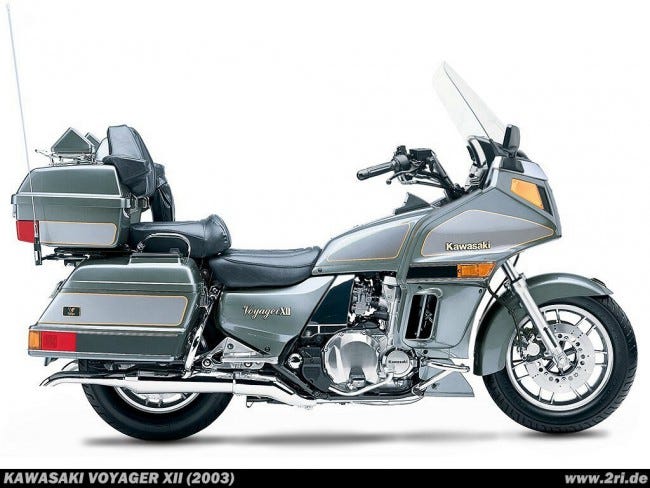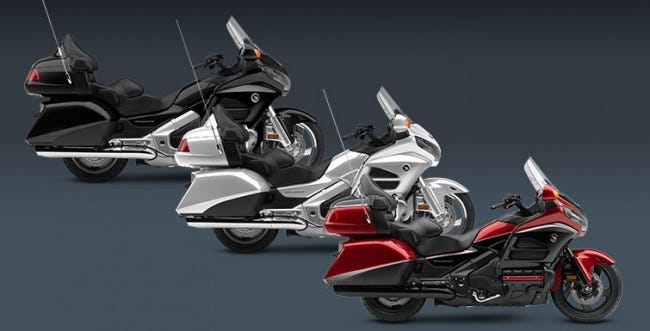Let Us Now Praise Things That Look Exactly Like The Honda Gold Wing

In an email conversation with a respected fellow automotive journalist last evening, I was accused of being a "secret GoldWing fan" or something to that effect. Needless to say, I violently resented the implication... that my admiration of the 'Wing was in any way secret. I could easily see myself owning a GoldWing. Maybe not right now, but certainly before I die. I have none of the contempt for the cross-continental set that seems to be part and parcel of sportbike or cafe-racer ownership. It's not yet the right choice for me, but that isn't to say that I would be unhappy to ride one over long distances.
The truth is that the GoldWing is one of those brilliant products that both defines a market segment and then comes to utterly dominate it. But that doesn't mean that the big Honda won the battle of the Yamato-class cruiser by default. Each of the Japanese "Big Four" fielded a Wing-alike in the Eighties. And the (relatively short) story of how and why each of the competitive products failed is worth a bit of examination, if only because the same thing happens everywhere from watches to handguns.

The original GoldWing doesn't look much like a GoldWing at all, does it? The original concept for the bike was that it would further the revolutionary work done by the original 1969 CB750. That bike was a chain-drive, air-cooled, inline four with two valves per cylinder operated by a single overhead cam. The GoldWing was a shaft-drive, water-cooled, boxer four with two valves per cylinder operated by a single cam in each head. The best way to think of it was as a BMW R-bike killer, since it had more power in a more compact package.

This is more like it, right? It's the 1981 GL1100 Interstate, the first "factory full dresser" and the template from which all future imitators would spring. Of course, people had been putting fairings on GoldWings (and everything else) for a decade or more, but this was the first bike that offered everything nicely integrated straight from the Marysville plant. It was such a brilliant idea that all three of Honda's Japanese competitors followed suit in short order. Oddly enough, the NonWings copied the style but not the fundamentals of the Interstate.

Yamaha struck first, with the Venture Royale. It was powered by a V-4 that would also make an appearance in the first-generation V-Max.

Kawasaki was next, using the inline-six from their Z1300 to make the Voyager 1300. It had fuel injection, which Honda wouldn't put on the Wing as a standard feature until 2001. (There were fuel-injected special-edition four-cylinder Wings.)

The final entry, in 1984, was the Suzuki Cavalcade. It was the biggest of the original Japanese tourers, had the largest engine, and boasted the most power. It was like the Hayabusa of GoldWings, you could say.

Kawasaki thought better of the six-cylinder Voyager and introduced an inline-four "Voyager XII" in 1986. It had four valves per cylinder and was the quickest tourer on the market when it was released.
What's interesting here is the sheer number of approaches tried:
boxer four (Honda)
V-4 (Yamaha, Suzuki)
inline four (Kawasaki)
inline six (Kawasaki)
At this point, it was anybody's game. The GoldWing had a sterling reputation, but the other bikes were also reliable and comfortable. Things could have continued like this indefinitely.

Except it didn't, because just as the other three Japanese manufacturers were getting the kinks worked out of their first-generation full-dressers Honda decided to set the bar too high for anyone else to reach. The GL1500 was outrageously massive --- so much so that it had a reverse gear that was powered by the starter --- yet it was easy to ride. It made the Venture, the Voyager, and the Cavalcade instantly obsolete. Suzuki gave up almost immediately, pulling the Cavalcade from the market in 1988. Yamaha hung on until 1993, while Kawasaki continued to build the Voyager XII in the United States until after the millennium. They actually sold a few in 2003!

The introduction of the GL1800 in 2001 was the final nail in the competition's coffin. While Kawasaki, Yamaha, and Suzuki all field big-bore touring bikes today, they are styled and engineered to compete with the V-Twin Harley-Davidson Electra-Glide, not with the flat-six Honda. That's because Harley is now the market leader for touring bikes. The "modern tourer" market really consists of just Honda and BMW now.
What I would suggest is that Honda "won" the Japanese tourer battle by being proactive, not reactive. They looked ahead and they didn't worry about what the competition was doing. But having won that battle, they stopped worrying about the segment, which allowed Harley, Indian, et al to come back and take a big slice of the pie. The current GoldWing platform is fifteen years old and there seems to be no plan to replace it.
Perhaps it's part of the ennui that seemed to seize Honda about ten years ago. The 2008 Accord was a disappointment and the 2012 Civic was just plain subpar. The current Odyssey doesn't have the virtues of its predecessor. Yet the company took action to revitalize the Accord and Civic in short order. Maybe they'll do the same with the GoldWing. But what could Honda do to improve over the current bike? What would be a technological leap that would get people interested in trading their old Wings in for new? My suggestion: a proper hybrid. Drop the engine size back to one liter and four cylinders. Make up the power gap with a synergy drive. Mileage would increase, and with it range, which really matters to the 'Wing crowd. It would be impossible to stall the bike if it used the electric motor from rest. Give it an all-TFT instrument panel and a new generation of radical looks.
There is a whole generation of "socially conscious" Gen-Xers out there who are going to turn fifty pretty soon. They've been driving Hondas and Toyotas their whole lives. Now's the chance to get them behind the bars of a hybrid GoldWing for their retirement years. I might not buy such a bike, but I'd sure like to see them on the roads. And I'd like to see the imitations, too. Can you imagine a quick-bake Suzuki hybrid tourer, eight hundred pounds of battery and plastic? Why not?

